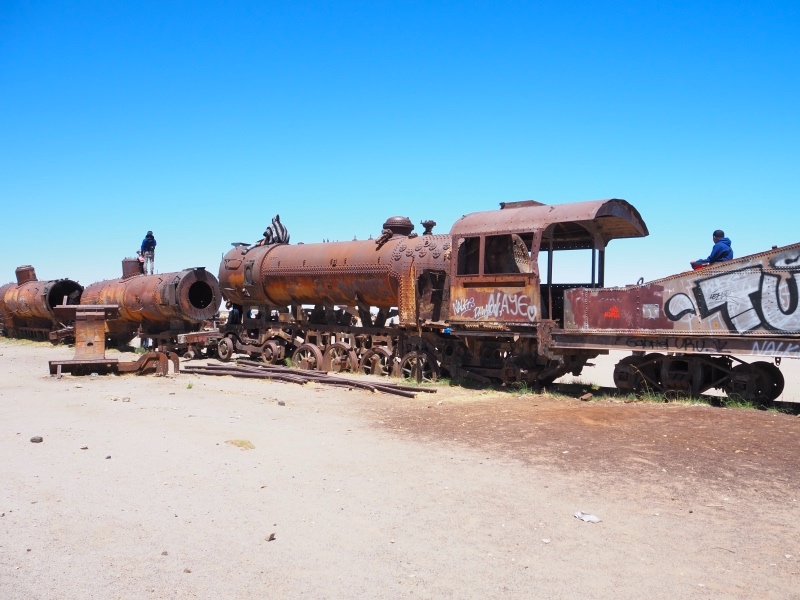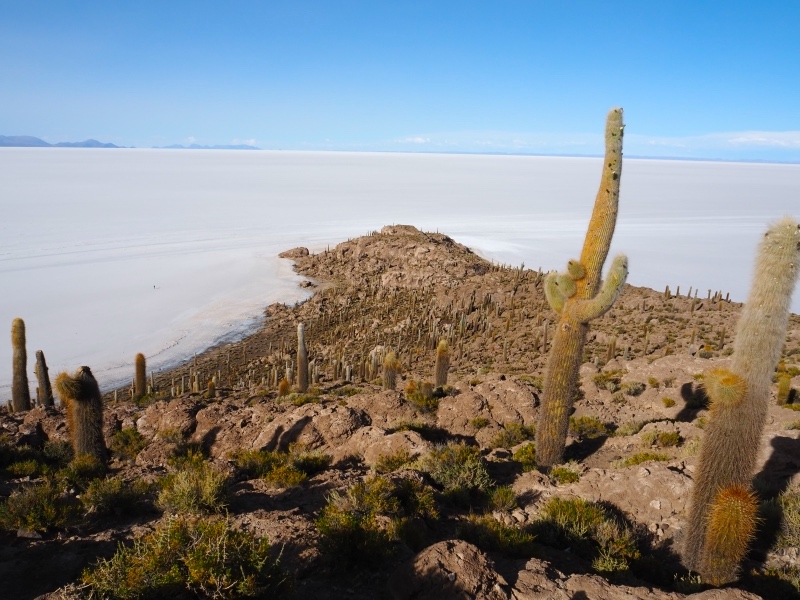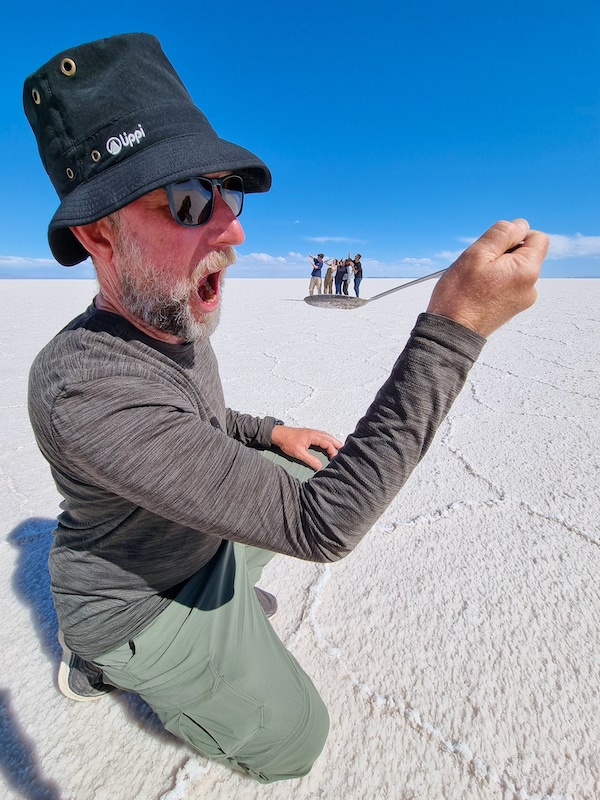One of the main reasons I came to Bolivia was to visit the Salar de Uyuni – the world’s largest salt flats. While getting into the country was a little convoluted (see last post), everything was smooth sailing once I made it to Oruro. From there, it was a straightforward run of just over 300km to Uyuni on Route 30.
Strangely, Google Maps described Route 30 as an ‘unknown road’, but the decent asphalt surface, ample signage, toll booths (which motorcycles get to zoom through for free – yay!) and reasonably frequent traffic belied the claim.
The Hotel Cesare was my home in Uyuni for two nights. If you ever find yourself there, I recommend it highly. For about A$25, I got a very comfortable room with private bathroom, double bed and the best pillows so far on this journey. And breakfast included.
The hotel is quite new and the owner Cesare is very hands-on. He’s also a lovely bloke – cheerful, attentive and happy to help in any way possible.
I decided early on that I wasn’t real keen to take the WR250R on the Salar. This time of year is the rainy season and there is often water (very, very salty water) on the surface in parts. Yes, there are plenty of places in Uyuni where you can get your bike washed afterwards, but I was quite happy to have a day off the bike and go with an organised tour instead.
Cesare hooked with up with local tour office and in about 20 seconds flat I had a full day outing arranged, including lunch and sunset viewing for A$50. Too easy.
I was picked up from the hotel next morning (honestly, I could have walked as the office was a couple of streets away, but hey – they offered) and after a cuppa and some formalities, the group assembled and we were off by just after 10.30am.
Our tour bus was a well used but sturdy LandCruiser 100 Series, of which there must be about 3000 in Uyuni. And they are all used for the same thing. I got the front seat next to driver Richar – happy about that.
First stop was the Cementerio de Trenes (Train Cemetery), which is just a dumping place of old steam trains that were previously used to transport minerals from the region. It was okay – I’m not massively into trains – but you only need about 10 minutes to see it.


Then it was back in the Toyota and off to Colchani, a small village about 10km outside Uyuni, where we (along with every other LandCruiser-mounted tour group) were given the opportunity to buy souvenirs and local crafts in one street crammed with such stalls and shops. Again, not really my thing, although I did buy a llama keyring which will be installed on the WR soon.
After supporting the local economy, we finally hit the Salar. Well, after driving down a hugely rutted dirt road that gradually turned to salt and looked like it would be hellish when wet, and after getting our passports viewed at a checkpoint.
The Salar de Uyuni is huge. It covers somewhere between 10,000 and 12,000 square kilometres and presents as a blindingly white, flat, barren landscape ringed by distant mountains. Some say it has a Mad Max feel, which is certainly true when scores of LandCruisers are charging over the salt to the next tour stop. Others say it feels other-worldly.
I found it stark. And beautiful. And incredibly quiet (when there were not other tour groups around…)

And when I say it’s blinding, I really mean it. My visit was on a cloudless day and when once I took off my sunglasses to adjust the camera, I had to whack them back on quick-smart because the glare from the salt was actually painful. Our guide, Richar, had reflective ski goggles on all day.
The salt crust is mostly a few metres thick and sits atop brine, which is rich in lithium. While it was mostly dry where we went (except for the sunset viewing) there were often potholes visible in the surface in which the brine could be seen.
Once on salt, there were a few attractions we stopped in at, such as the famous Dakar Bolivia sculpture – built from salt – erected a few years back when the famous off-road rally was held in South America; and the salt hotel – built from salt – where we had our lunch.


From there, we drove for about an hour straight across the Salar, heading for Isla Incahuasi – one of several islands that pop up through the salt. Incahuasi is managed as a national park and there is a great walk up the main hill and back down again which gives some incredible views. It is covered in tall cacti, and much of the rock looks like coral – a remnant of when the Salar was a lake.
We drove for another 45 minutes or so to the final point of the tour. It was quite a sight – a long line of LandCruisers parked on one of the wet parts of the Salar to witness the sunset. The water is only a few centimetres deep above the salt, but it produces an incredible mirror effect on the surface.
Richard handed out gumboots to wear in place of our shoes, and set up a table with glasses of wine and nibbles so we could imbibe while watching the sun complete its descent. Very civilised.








Next day I shipped out to Potosi. Well, that was the plan, but the WR250R refused to wake. It had been getting a little harder to start over the past week, and I wasn’t sure what was causing it – perhaps the altitude or maybe Bolivian fuel.
I did the usual process of elimination – we had power, we had fuel, but we had no spark. Check the spark plug. This is a bit of a mission on the WR as the seat and the fuel tank both have to be removed, and the Safari tank is an unwieldy thing, especially when it is full. Luckily, I didn’t have to remove it completely, but could undo all the bolts and sort of shove it to one side to get access to the coil cap and plug.
I couldn’t get the bloody coil cap off at first. It’s supposed to be a no-tools job, but it wasn’t shifting so I wrapped a cable tie around the top to make a loop and give some extra leverage. Thankfully, this worked and I was able to extract a pretty tired and dirty-looking spark plug.
The ever-smiling Cesare came to the rescue with some sandpaper so I could clean up the plug tip, and we both gave a cheer when the bike fired up first go after the plug was reinstalled.
I reached Potosi a couple of hours later than planned, but it was no big deal as the ride was fairly short one anyway.
I have since picked up a couple of new sparkplugs – one has gone in the bike and the other in the toolkit as a spare. Happy to report it is starting and running well, although the chain and sprockets will need replacing fairly soon.
Potosi is interesting and Sucre is a rather cool place. I will write more about these later. My thoughts in recent days, however, have been dominated by the unrest in Peru, which seems to be getting worse. As I write this, about 50 people have died, there are roadblocks all over the country and especially in the south, and big protests are happening in the capital, Lima.
Many Peruvians – mostly from the poorer southern regions such as Puno, Cusco, Juliaca and Arequipa – are extremely angry and disillusioned with their government leaders. The protests were sparked by the arrest of the president Pedro Castillo in December after he attempted to dissolve the nation’s Congress.
From what I understand, the leftist Castillo was very popular among Peru’s rural and working class constituents, many of whom also hold the Congress in contempt as corrupt. These are the people who are rising up the only way they know how- through roadblocks and protests – in a bid to force Castillo’s successor, Dina Boluarte, to resign, get Congress dissolved and have fresh elections held this year. Boluarte is standing firm, so the deadlock shows no sign of resolution.
My travel plans are absolutely insignificant next to the struggles of Peruvians to be heard, but there’s no doubt this turmoil has placed a major obstacle in my path. My original plan was to continue through Bolivia and cross the border into southern Peru at one of the two major crossings near Lake Titicaca. From there, I was hoping to venture on to see Machu Picchu.
It is pretty clear now that the latter ain’t gonna happen, and the former is looking decidedly sketchy as well.
The busiest border between Bolivia and Peru – Desguadero – is closed, barricaded on the Peruvian side with rocks, tyres and barbed wire. Trucks are banked up for kilometres on the Bolivian side and trade between the two nations has come to a shuddering halt. So that’s a no-go.

It looks like I have five options at this point:
- Try to cross the border into Peru near Copacabana. Although it supposed to be a lot quieter than Desaguadero, I haven’t been able to determine if this crossing is actually open. And even if it is, I would still be in one of the most troubled areas with roadblocks a-plenty.
- Cross into Peru further north at Puerto Acosta-Tilali. I am hearing this is open, but because it is pretty remote there is no customs on the Bolivian side and getting all the requisite exit paperwork finalised for myself and the bike could be a problem. Again, roadblocks and unrest are an issue if I do get into Peru successfully.
- Cross into Brazil at Cobija and then try to loop into Peru further west, but with potentially the same problems as options 1 and 2 once I am in Peru.
- Head east from Santa Cruz in Bolivia and enter Brazil at San Matias, then try to make my way north to Manaus or Santarem. From those places, I am told it is possible to get a boat up the Amazon River to Leticia in Colombia near the far eastern corner of Peru, then another to Iquitos and yet another boat to Ecuador along the Rio Napo. This could take a few weeks, assuming I can make the required connections in the first place.
- The last is to find a freight agent who can help me arrange to fly the bike directly to Panama. I would have to fly the bike from Colombia to Panama anyway, due to the Darien Gap. Going direct from Bolivia would mean missing out on Ecuador and Colombia altogether, which is not really desirable, not to mention the expected cost.
It’s an interesting dilemma. All options have elements of risk, and I don’t know whether the potential adventure of heading to the Amazon and chancing my luck with the river boats is preferable to dodging roadblocks and protests in Peru, assuming I can get into that country in the first place.
Stay tuned.


Comments
6 responses to “Salar dreaming”
Until, recently I didn’t even know about the salt lakes. It’s so enjoyable to read your stories and learn about these amazing places. You’ve captured it so well through your writing and the photos I can almost imaging what it would have been like to be there. I love the funnies too! Couldn’t help but have a giggle, your guide sounds like a character.
The photos are great and you tell the story so well it’s easy and enjoyable to follow. Thank you for taking the time to share it.
I’m sorry you’re stuck with no real choice of border crossings. Hopefully the situation will improve soon and you can continue on your journey. Meanwhile, sound like Bolivia isn’t too bad a place to get stuck in while you wait it out.
I’m definitely interested to see what happens next.
Hey Pete, Laughed out loud at those great photos on the salt flats, whilst in the checkout queue at Woollies. So good.
Stay safe, hope the right path opens up in front of you.
Politics, politics, fucking politics! Is there anywhere in the world you can go without the problems of politics?
Loved your description of the salt plains amigo. I don’t think there is many who could describe it as well as yourself. Not to mention the great photos.
One question……..what’s with the hat?
The news here regarding the issues in Peru is not good my friend. Stay safe and head for happier trails.
What’s wrong with my hat? I bought it in Chile because it provides more overall sun protection than a cap. Not like you’re one to talk about being fashionable… 😂
Hey Pete, awesome post and photos! Struggling today, first day back at work after a month off!
Vicariously enjoying your adventure! 👍😀
Pete, I must say I was a bit concerned about your forward journey after reading this post but have great confidence that you will find a workaround to get you moving in the right direction. Once again, beautiful photos and interesting narrative. I am learning a lot about South America. Stay safe.